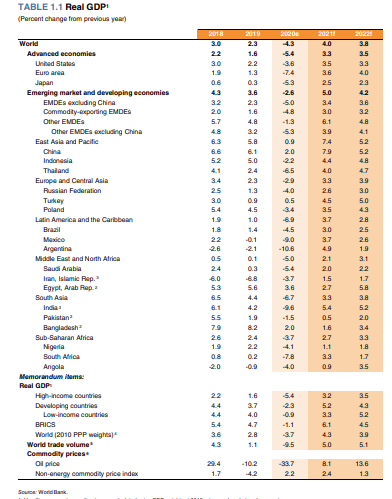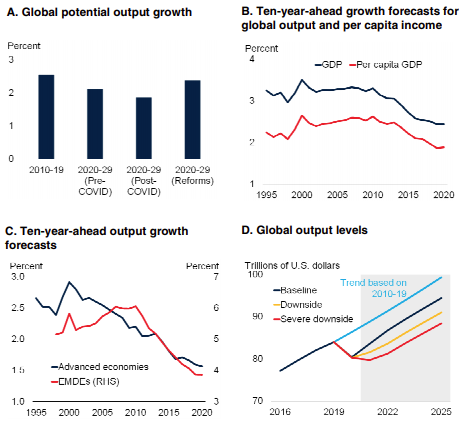World Bank 2021
“COVID-19 caused a global recession whose depth was surpassed only by the two World Wars and the Great Depression over the past century and a half. Although global economic activity is growing again, it is not likely to return to business as usual for the foreseeable future. The pandemic has caused a severe loss of life, is tipping millions into extreme poverty, and is expected to inflict lasting scars that push activity and income well below their pre-pandemic trend for a prolonged period.” (World Bank, Global Economic Prospects, Jan. 2021.)
“Even after the recovery gets underway, there is expected to be a protracted period of below-trend global output, with substantial per capita income losses. In the baseline scenario…. there would be a cumulative output loss during 2020-25 equivalent to 36 percent of 2019 global GDP.” (World Bank, Global Economic Prospects, Jan. 2021.)
The World economy was slowing for a full decade before Covid-19. The pandemic guarantees even slower long-term growth into the future. Not surprisingly, the global recovery this year won’t even replace the losses incurred 2020.
The latest World Bank projections for the global economy are both discouraging and unfortunately awfully familiar.
The past experience of the advanced economies is that recessions and financial crises are typically followed by years of disappointing economic growth and repeated downgrades to economic projections.
The latest World Bank projections acknowledge that the pandemic recession caused a huge drop in global output in 2020 and projects a slow-growth recovery in 2021. The accompanying projections are in line with the prevailing consensus that the pandemic will be gradually brought under control later this year due to the increased availability of vaccines.
However, the most telling message from the World Bank report is the conclusion that the pandemic has already disrupted key drivers that support long-term economic growth.
Even before the pandemic, slowdowns in the important drivers of growth indicated that annual average potential GDP growth would slow by 0.4 percentage point globally, and by 1 percentage point for the emerging market countries (EMDEs) over the 2020s.
Because of the pandemic, the expected slowdown in potential growth in this decade is expected to be even steeper.
(In the following table of projections, the EMDE is the short form for emerging market and developing countries.)
The key drivers which affect long-term growth include the twin weakening outlook for global investment and consumer spending, as well as a slowing in future per capita income growth.
Experience suggests that a prolonged period of depressed capital spending together with higher unemployment is likely to erode human capital as well as the physical capital stock.
As it is, the pandemic has already triggered costly reconfigurations in many global supply chains and working arrangements in many industries.
And although the household savings rate may appear unusually high in advanced countries due to the pandemic and government relief programs, there is little confidence that consumer spending will pick up sharply once the pandemic recession is over.
In other words, unless there is some new technological breakthrough that will offset all of these potential negatives, the pandemic is likely to weaken growth prospects for rest of this decade.
Of course, if there were major policy reforms in these countries that support investment, improve education, and raise labor force participation, they would minimize much of the adverse lasting impact of the pandemic on potential growth. But don’t hold your breath waiting for these policy reforms.
In terms of the short-term outlook, the World Bank forecast indicates that the global economy shrunk about 4.3% in 2020 and should recover about 4% in 2021.
With respect to the larger economies in 2021, the US real GDP is projected to grow about 3.3%, the euro area region about 3.5%, and Japan about 3.1%.
In other words, the projected recoveries of these advanced economies in 2021 are below the losses experienced in 2020.
World Bank Global Economic Outlook
(Click on image to enlarge)

World Bank Long-Term Growth Prospects After The Pandemic
(Click on image to enlarge)





The world bank is always an interesting topic, thanks for the post.
Certainly the damage done by this plague is great, and there certainly will be scars lasting at least one generation, probably more.
But the crying over reduced growth does seem rather selfish, and indeed the main group that benefits is the financially elite. Stability with a bit of growth is adequate to serve the rest of us, except that now recovery is what we need, and the means to recovery are not obvious right now. The loss of jobs and the collapse of so many businesses and even industries has done serious damage, and the recovery will be neither easy nor rapid. And the damage to some areas is already incredible.